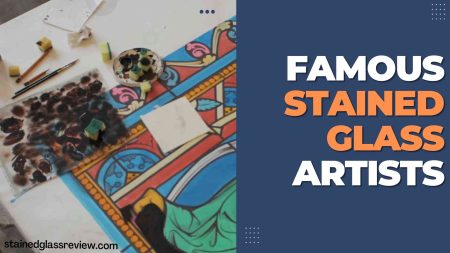There’s something about stained glass that just makes people happy. Maybe it’s the bright colors or the intricate designs, but there’s no denying that stained glass is beautiful. And it’s not just for churches anymore- you can find stained glass windows in homes, offices, and even restaurants.
But what is stained glass, exactly? Stained glass is a type of window panes made from colored glass. The glasses are cut into small pieces and then arranged into a design. The final product is held together by a lead or metal framework. Stained glass can be clear or opaque, and the colors can be very bright or more subdued.
No matter what your taste, there’s sure to be a stained glass window that you’ll love. So go ahead and let the light in your home thank you for it.
This article will tell you everything about stained glass.
What is Stained Glass?

Stained glass is a type of glass that has been treated with chemicals or other substances in order to give it a specific color.
The earliest known examples of stained glass date back to ancient Egypt, where it was used to decorate royal tombs. In the Middle Ages, stained glass became popular for use in churches and other religious buildings.
The beautiful colors and patterns of stained glass were thought to symbolize Heaven, and they helped to inspire worshipers during services.
Today, stained glass is still used in many religious buildings, but it can also be found in secular settings such as restaurants, hotels, and public parks. Whether used for decoration or utility, stained glass is a timeless art form that continues to be enjoyed by people all over the world.
Early History

Stained glass has a long and storied history. Though its origins are somewhat murky, it is believed that the first stained glass windows were created in Egypt and Rome.
These early windows were made from pieces of colored glass held together by lead or wood. By the Middle Ages, the art of stained glass had spread to Europe, where it reached new levels of sophistication.
Gothic cathedrals featured intricate windows depicting religious scenes, while royal palaces boasted colorful panels adorned with heraldic symbols. In the modern era, stained glass has lost some of its former popularity, but it remains an essential part of architectural traditions around the world.
The history of stained glass is a long and varied one. From its origins in ancient Egypt and Rome to its resurgence in the modern era, stained glass has always been a popular form of decoration.
Gothic cathedrals were some of the first buildings to feature elaborate stained glass windows, and the tradition has continued to this day.
Modern Techniques

While the basic concept of stained glass has remained the same for centuries, the techniques used to create it have evolved significantly.
In the past, most stained glasses were made by hand, which limited the size and complexity of the designs that could be created. However, modern technology has made it possible to create much larger and more intricate windows.
This has allowed for a resurgence in the popularity of stained glass, as more people are able to appreciate the beauty of these works of art.
If you’re interested in learning more about stained glass, there are plenty of resources available. You can take classes, read books, or even watch videos online.
Here are some of the modern techniques:
Using Lead Came
One popular technique is the use of lead came. Lead came is a type of metal strip that is used to join pieces of glass together. Lead came is available in a variety of widths and can be bent into any shape, making it ideal for creating complex designs.
Use of Copper Foil
Another popular technique is the use of copper foil. Copper foil is wrapped around the edges of each piece of glass before it is soldered together. This technique allows for finer details and a smoother overall finish. Whether using lead came or copper foil, the possibilities for creating beautiful stained glass art are endless.
Lead Knife Cutting
Lead knife cutting is a traditional method of creating stained glass windows. The process involves using a lead knife to score the glass before breaking it apart. This technique is often used for creating simple designs or for repairing existing windows.
Stained glass is a beautiful and timeless art form. Whether you’re interested in learning how to create your own
Old Techniques

Stained glass has been around for centuries, and the old techniques used to create it are still used today. The most basic technique is to cut out the desired shape from a piece of glass. Next, the edges of the glass are smoothed and then the glass is placed in a lead came.
The lead came is then soldered onto a metal frame, and the glass is heated so that the solder flows into the cracks between the pieces of glass. This creates a strong bond that holds the glass in place.
Finally, the finished piece is polished and cleaned, and then it is ready to be installed. Although the process is relatively simple, it takes a great deal of skill and experience to create beautiful stained glass windows.
Stained Glass Art

Stained glass art is truly something to behold. It’s intricate, colorful, and often downright beautiful. But what exactly is it? Simply put, stained glass art is created by using colored glass to create a picture or design.
The glass is usually cut into small pieces and then assembled into a larger panel. The panel is then placed in a window, allowing light to shine through and create a stunning effect. Not only does stained glass art add visual interest to a space, but it can also be used to tell a story or convey a message.
For centuries, stained glass panels have been used to depict religious scenes or important historical events.
Today, they can be found in homes, churches, office buildings, and more. Whether you’re looking for a way to add some personality to your space or you’re simply curious about this fascinating art form, stained glass is definitely worth checking out.
Purpose of Stained Glass

The purpose of stained glass is to color the light that passes through it. Unlike painting, which adds color to a surface, stained glass actually changes the color of the light itself. When sunlight passes through a stained glass window, the different colors of the glass filter the light into a spectrum of colors.
The resulting images are often complex and beautiful, making stained glass a popular choice for both religious and secular buildings. In addition to its decorative purposes, stained glass can also be used to create practical items like drinking glasses and windows for greenhouses.
However, its most common use is still in churches and other places of worship, where its colorful light has long been associated with spirituality and mystery.
Famous Stained Glass Artists Through the History
Stained glass is a type of art that has been around for centuries. Early examples of stained glass can be seen in churches and cathedrals all over Europe. The beautiful colors and intricate designs of stained glass have always been popular with people of all ages.
Today, there are many famous stained glass artists who create stunning works of art. Some of the most popular stained glass artists include:
1. Louis Comfort Tiffany- Tiffany is one of the most famous stained glass artists of all time. He was born in 1848 and died in 1933. Tiffany is best known for his beautiful stained glass windows and lamps.
2. John La Farge- La Farge was born in 1835 and died in 1910. He was an American painter and stained glass artist. La Farge is best known for his work on the interior of the US Capitol building and the St. Patrick’s Cathedral in New York City.
3. Marc Chagall- Chagall was born in 1887 and died in 1985. He was a Russian-Jewish artist who is best known for his stained glass windows.
4. Joan Miro- Miro was born in 1893 and died in 1983. He was a Spanish painter and sculptor. Miro is best known for his surrealist artworks which often featured elements of nature.
Famous Stained Glass Designs

Here is the list of names of some of the most popular and renowned designs of stained glasses:
- The Rose Window at Notre Dame Cathedral, Paris
- The Great West Window at York Minster, England
- The East window at Canterbury Cathedral, England
- The West window at Chartres Cathedral, France
- The North transept window at Cologne Cathedral, Germany
- The Baptistery window at Florence Cathedral, Italy
- The South rose window at Westminster Abbey, London
- The West rose window at Strasbourg Cathedral, France
- The East window at Durham Cathedral, England
- The Rose Window at Saint Mark’s Basilica, Venice
Frequently Asked Questions
How is stained glass made into art history?
Stained glass has been used for centuries to create beautiful works of art. The process of making stained glass is actually quite simple. First, a design is created on paper. Next, the design is transferred onto a piece of clear glass. After that, pieces of colored glass are cut to fit the design and then soldered together.
What is stained glass called?
Stained glass is also known as leaded glass or painted glass.
What are the different types of stained glass?
There are three main types of stained glass: clear, opalescent, and frosted. Clear stained glass is the most common type and is typically used in windows. Opalescent stained glass is made with multiple layers of colored glass and can be used in windows or as decorative accents. Frosted stained glass is made by adding a frosted coating to the glass, which gives it a blurry appearance.
What are some popular techniques for making stained glass?
There are many different techniques that can be used to make stained glass. One popular technique is Tiffany glass, which is made by soldering together pieces of colored glass. Another popular technique is painting on the glass with enamels or vitreous paint.
Conclusion
This is all about stained glass and I hope you have got plenty of knowledge about it. Thank you for staying with us till the end. Stay tuned for more such interesting topics.














